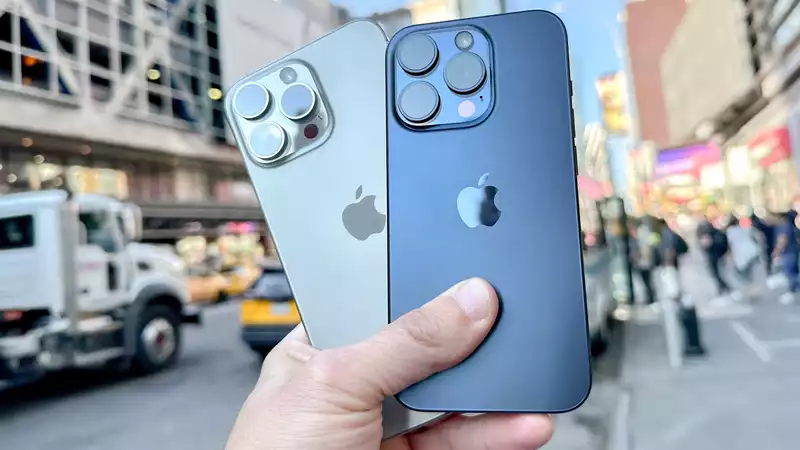One of the advantages of having an iPhone 15 Pro or iPhone 15 Pro Max is that it can transfer data much faster than any other iPhone, including the standard iPhone 15. However, you will not be able to take advantage of that faster speed right out of the box.
The iPhone 15 Pro supports USB 3.0 speeds of up to 10 Gbps, but the included USB-C cable is limited to 480 Mbps. This is USB 2.0 speed, more than 20 times slower than the maximum available speed. This means that a better cable would need to be purchased.
These cables are not cheap, but with the Black Friday sales season underway, you may be able to get the right equipment for less. iPhone 15 Pro and iPhone 15 Pro Max need the following to enjoy the fastest data transfer speeds are.
The most important thing to do before purchasing anything is to double check which iPhone you actually have. Currently, faster data transfer speeds are limited to the iPhone 15 Pro and iPhone 15 Pro Max.
If you own an iPhone 15, iPhone 15 Plus, or an older model iPhone, you are stuck with the same slow speeds as before. This means you should stick with the cable that came with your phone. Because buying a faster cable won't change anything.
The easiest way to double check if you have an iPhone 15 Pro. Look for the solid state action button on the left side of the device. If you have this button instead of the mute switch, you can start looking for a better cable.
Aside from having the right kind of iPhone, the most important factor in getting fast data transfer speeds is getting the right kind of cable. As mentioned earlier, the USB-C cables that come with each iPhone 15 are only capable of 480 Mbps. These cables are also quite confusingly referred to as "Hi-Speed USB" by the USB Implementer's Forum, which supports the USB standard.
Thankfully, buying the right USB-C cable is not difficult. You need a cable that offers at least 10 Gbps data transfer speeds; 20 Gbps, 40 Gbps, and 80 Gbps options are also available, but they are often more expensive and offer no additional benefit.
Another option is to choose a Thunderbolt 3 cable, which supports up to 40 Gbps data transfer and has the same USB-C connector; Thunderbolt 3 cables offer more advantages compared to equivalent USB-C cables and are therefore more It is worth noting that they are more expensive. iPhone 15 Pro does not support Thunderbolt 3, so these cables are virtually useless. However, if you have a Mac or other computer that supports Thunderbolt, the cables could serve double duty.
Currently, the only suitable cable sold directly by Apple is the $69 Thunderbolt 4 cable. All other USB-C cables in the Apple store are for charging and are at best USB 2 480 Mbps.
USB-C cables are available almost everywhere online, so just be sure to buy a legitimate cable from a reputable seller rather than the cheapest option available.
The last part of the iPhone 15 Pro data transfer equation is the storage device: either a Mac or an external storage drive, wherever data can be transferred.
Finding the right device is not that different from finding the right USB-C cable, in that you need to find a USB-C cable that supports at least 10 Gbps transfer speeds.
For external drives, whether hard drives or SSDs, manufacturers are usually quite transparent about the maximum speeds available. This is because different versions of USB have come and gone, all with very similar names and different transfer speeds. This means that it can be quite confusing.
As with cables, choosing a drive that supports speeds of 10 Gbps or faster, or at least Thunderbolt 3, will give you the right speed. However, unless you plan to use the drive with other devices, you will be paying extra for something that is not fully utilized. Labels such as
or USB 3.2 or USB 3.1 Gen 2 are good indicators that the drive is fast enough. However, we always recommend double-checking the specs before purchasing.
The same goes for desktop machines and laptops that you already own. Typically, one or more of the USB-C ports will offer data transfer speeds of USB 3.0 or faster, and many high-end machines have at least one Thunderbolt port. The new MacBook Pro M3 has three Thunderbolt 4 ports.
These may or may not be labeled. The only way to know for sure is to check the specs - be it on the machine itself or on the manufacturer's website.
The iPhone 15 Pro's USB-C port is useful for many things, not just data transfer. One of the biggest of these is the ability to record up to 4K/60fps ProRes video directly to an external storage device, given the right equipment.
Not available with other video recordings, this means that such large video files do not have to take up space on the iPhone - or be forced to sit and wait while they are transferred elsewhere. The transfer requires a fast enough cable and storage device.
The port is also compatible with CarPlay-enabled cars, external displays, microphones, battery packs, USB Ethernet adapters, and SD card readers. Most of these were also possible with USB 2.0, but support for external displays, for example, relied on USB 3 for high-speed data transfer. Therefore, make sure you have the appropriate cables on hand.
.









Comments